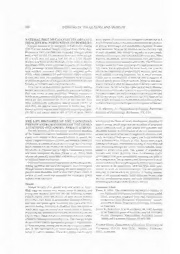
Natural diet of Callinectes ornatus (Brachyura: Portunidae) in Bermuda PDF
Preview Natural diet of Callinectes ornatus (Brachyura: Portunidae) in Bermuda
398 MEMOIRS OF THE QLEENSLAND MUSEUM NATURAL DIET OF CALLINECTES ORNATUS many studies of crustacean diet relegated such ennties 1 a (BRACHYURA; PORTUNIDAE) IN BERMLDA A-NutfiHOnal status, Other papers documented the presence Foregut contents of 56 specimens of Callinectes arnatus of diverse microscopic and meiohenthic organisms In coral (8,8-51.8 mm carapace length) collected trom Mulley Bay, sand substrates, Because the biomass cun be relutively high Bermudai n 1981 and (988 were examined. Foreguis which in such substrutes, they should be regarded as a potentially were = half full (91,1%) contained more prey items per gut important food souree, and considered part of the diel. Plant (X = 4.67) than did guts = half full (X = 2.73). Dictary milteridl, crustaceans, nereld polychaetes, fish, and bivalve analysis was based on two methods; (1) the index of relative Molluses ranked fourth though eighth in IRL The PTS index importance (IRI), which combined frequency of occurrence is better suited for foods consisting of uw high proportion of (FO), percentage of total blomass (GC), and percentage ot sott tissue, FO ls appropriate for most foods, but tends 1 lolal numbers consumed (NC). and (2) weighted points elevale the importance of unidentifiable material, sand, and (PTS), which combined FO and estimated relative volumes small animals occurring frequently, but in smal! amounts. of each prey item. No signiticant differences were revealed Errors die to accumulation of material that Is digested of in relative proportionso f foregur contents beiween males and cleared slowly oveurs in both methods. While ao one quan- females, or between adull and juvenile crabs. lilulive method ts ideal for assessment of dictary analysis in This crab is an OpportuMisic predator of slawly moving Hrachyurans, the (RI value has 4 greal deal of merit, Because benthic macroinvertebrates, specifically gastropod malluses. IRI Is based on three other indexes, itis possible ky determine Pier was related in prey avallabliiy, Modulus moduli, a the relative impact that each component Index hawsn t he total cerithiacean gastropod that grazes algae and Tralassia, dom- IRI for the dietary items, and because the PTS method has inated the diet, accounted for 21.1% of the rorl IRL Two been Widely accepted, i is fecomimended that future dietary other cerithiaccans collectively tanked socund (19.96) of studies of brachyorans be designed to incorporate all indexes. loll IRI). All species were common in Mullet Bay. Car- PLA. Maefner, de, Deparrment of Biology, Rochester bonate substrate was (he mosl (frequently occurring category (51.79%) and ranked third in [RI (17.2% of total). Whele Jastitute of Tecknolegy, Rachester, NY, USA. THE LIFE HISTORIES OF THE TASMANIAN separated Gn the basis of ovary development, presence of FRESHWATER CRAYFISHES OF THE GENUS Cggs or young, moult stage and the condition of secondary ASTACOPSIS (DECAPODA: PARASTACIDAE) sexual characters such 4s glair glands and ponopore and The life histories of the two poorly understoud members pleupodal setation. Representatives of the two reproductive of the Tasmanian endemic freshwater crayfish genus Asta- groups occurred in collections hroughou) the duration of the copsis wore studied in their natural habitats. A. gould, the study. In males of both species, sperm Was found within (he world's largest freshwater crayfish, and therefore (reshwuter vasa deferentia from February a May Sperm tubes began crustaceyn, is cupable of reaching very large size (3 lo 4 kg) forming in February, their number peaking in early May and and is restricted to the rivers of the north of Tasmania while then decreasing through the winter, Unlike females, males the smaller A, franklin? (up to 1 kp) is Widesproud in rivers appear to breed every year. The gonads of reproducing and Jakes throughout the siale (Swain ev al,, 1982), Both females and males therelore show synchronous eyelic species are generally associated with swill and cuol riverine development with peak development occurring just prior to or highland lacustrine habitats. the mating season. The postembryonic development in Aste- Male and female seasonal reproductive and moulting cycles, copsts cansisis of four morphologically distinct larval stages malting, spawning and larval development, were investiguled and appears to be significantly different from other para- through intensive monthly sampling and mark-récapiure pro- slicids as well as astacids/cambarids The development gramme from Seplember 1985 to May 1987 (Hamp, 1990) A sequence is considered lo be primitive in having retained portion of each caich was preserved for subsequent gonad some of the ancestral marine larval ehyracters in particular analysis in the laboratory the four developmental stages, and early differentiation of swimming appendages in the form of # fall fan, Results. Matore females of A, gouldi mate and spawn in April Literslore Cited May. eggs are carried over winter, hatch in January and Harr, P. 1990, 8The comparative reproductive bidlegy of young stay aached unl late into the tollowing summer the Tasmanian freshwater craylishes Ayiacapsis wouldi (March-April), After the release of their broods. females Clark, Astacopsts frankliui Grey and Parastacoides overwinter, then moult in mid-summer (January-February | tasmanicus Clark (Decapoda: Parastacidac)= Unpub- and mate and spawn again in autumn, bvo yours after their lisned Ph_Ty. thesis, Department of Zoology, University previous mating. SimilaA,r frlanykl,ine l mate and spawn in of Tasmania, April-May, eggs are carried over winter, hatch in January, Swain, R., Richardson, A.M,M. and Hortle, M. 1982, Revision and young stay attached until well into the follawing autumn of the Tasmaninn genus of freshwater crayfish Astacopsis (April-May). Aduli femules of Asracapyis therefore exhibit Huxley (Decapoda: Puraslucidae). Austratian Joumal i biennial breeding and moulting cycle, This sirategy results Marine and Freshwarer Research 33; 69-709, in bwo distinct female reproductive groups: |. reproductive, Premek amr, Department of Zoology, University af or (hose moulling. mating and spawning in 4 given summer and, 2. non-reproductive, or those incubating young and Tasmania, GP.Q. Box 252C, Mobart Tasmania larvae ina given summer, These iwo groups cin be vasily 7001, Australia.
